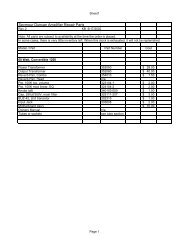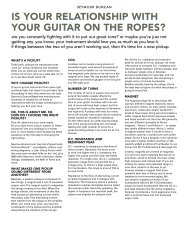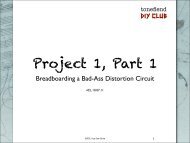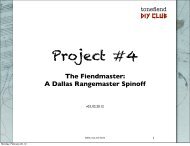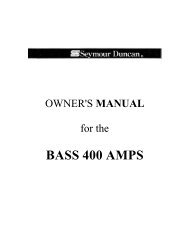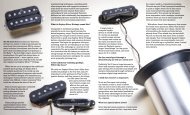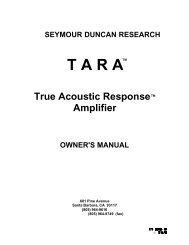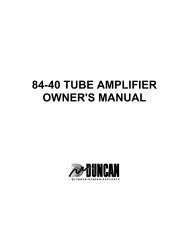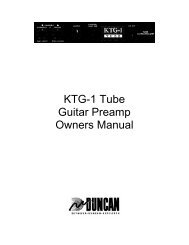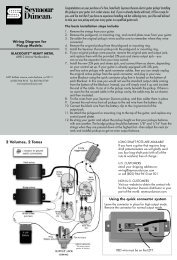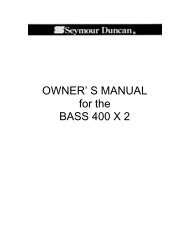100 Watt Convertible™ Amp - Seymour Duncan
100 Watt Convertible™ Amp - Seymour Duncan
100 Watt Convertible™ Amp - Seymour Duncan
You also want an ePaper? Increase the reach of your titles
YUMPU automatically turns print PDFs into web optimized ePapers that Google loves.
Convertible amps are designed with Accutronics 2-spring reverbs. These are the most<br />
natural sounding reverb units available and they provide a wide range of reverb for your<br />
playing styles.<br />
7) PENTODE/TRIODE SWITCH: This switch changes the operation of the EL-34 output<br />
tubes, which use five components inside each tube. With this switch in the up position,<br />
the tubes run in the Pentode mode and all five components operate for full <strong>100</strong>-watt<br />
power. The sound is brighter and crisper.<br />
With the switch in the down position the tubes run in the Triode mode and three<br />
components operate for 60-watt maximum power. The sound is smoother with a little<br />
less edge. Experiment with this switch to find where you like it for your musical style.<br />
Some amps have 60/<strong>100</strong>-watt switches. What they do is turn off the voltage to two<br />
tubes. That causes the power to drop but also places stress and wear on the two tubes<br />
that are on. The Pentode/Triode switch allows all tubes to run stress-free and provides<br />
longer life to all the tubes.<br />
8) VARIABLE DAMPING: This circuit is included with Convertible amps to give you<br />
more control over your sound. Damping is the amount of control the amplifier has on the<br />
speaker. High damping (turning the control to the right) increases the control of the<br />
speaker - the sound is crisper and tighter. Low damping (turning the control to the left)<br />
decreases the control of the speaker - the sound is looser and fatter sounding with<br />
slightly more presence.<br />
There is no recommended setting because only you can tell what's best for the sound<br />
YOU want to produce. This control is effective ONLY when the speaker is connected to<br />
the "Variable Damping Out" speaker jack.<br />
9) 4 OHM, 8 OHM SPEAKER JACKS: You can use these jacks to match the amp<br />
impedance to the input of the speakers you use. Proper connection to these jacks will<br />
give you maximum power and maximum damping.<br />
If you choose to run an 8 ohm speaker in the 4 ohm jack, no damage will result in the<br />
amp or with the speaker, it will just sound different from being played through the 8 ohm<br />
jack. The same situation is possible with a 4 ohm speaker in the 8 ohm jack.<br />
You can also use all three-speaker jacks at the same time with different speakers. The<br />
Convertible amp's strong transformer can handle almost any load with no damage.<br />
10) SLAVE OUT: Use this jack for patching the output signal of the amp directly into a<br />
mixer, tape recorder, or another amp. Just use a regular guitar cord from Slave Out to<br />
the guitar input of the other unit. The circuit is wired after the output stage so all tone,<br />
volume, damping control, effects loop, etc. controls will affect the outgoing signal. Output<br />
is one volt at full power.



